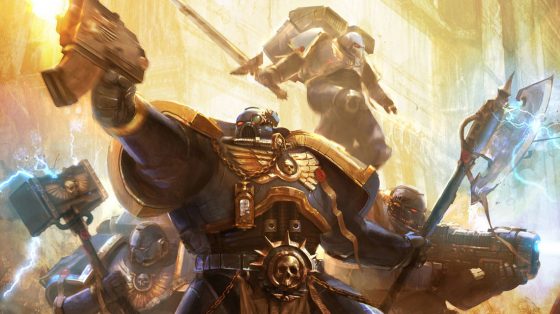
Gaming offers an imaginative space in which new worlds may be conceived or old worlds replicated. In light of the Christchurch shooting, many are examining video games and related subcultures to understand how the alt-right appropriates specific imagery, breeding ideology online. Tom Jeffreys, instead, looks at how contemporary artists re-appropriate this same material, specifically from Warhammer 40,000, in order to potentialise freer, queerer futures.
“In the grim darkness of the far future there is only war.” The apocalyptic sci-fi universe announced by the tagline for tabletop game Warhammer 40,000 does not, at first, seem like fertile terrain for contemporary artists. However, in recent years a number of artists have returned to their childhood passion in order to rethink its signs and symbols through the lenses of queer theory, postcolonial theory and the discourse around the Anthropocene. In the aftermath of the Christchurch shootings, as conversations grow around the link between violent video games and white supremacism, contemporary art is providing, in its own way, a direct challenge to the politics of fascism.
Warhammer 40,000 (40K) was launched in 1987 by a small games company called Games Workshop (GW). The game’s universe centres on a bio-engineered militarised division of humanity known as Space Marines, who are tasked with protecting the Imperium, a culturally ossified, space-straddling empire —like the Galactic Padishah Empire in Dune or the Galactic Empire in Star Wars (but less efficient and more Catholic). The Imperium’s main threats are the four Gods of Chaos, but there are also a number of other races battling against the Space Marines, and against each other. Several of these are futuristic projections of established fantasy creatures such as Space Orks (orcs) and Eldar (elves). As the tagline suggests, the universe of 40K is unrelentingly bleak.
The hobby itself consists of a rule-heavy tabletop game, for which people collect, assemble and paint miniature models, as well as build armies. Numerous books flesh out the universe’s narratives well beyond the rules of the game. Like the best sci-fi, 40K is a fully realised universe, rich with intriguing characters, imagery and back-stories. Nonetheless, these publications rarely stray far from the central focus: war.
Since starting as a games import business in 1977, Games Workshop has grown exponentially. Following a management buy-out in 1994, it has become a global business traded on the London Stock Exchange. Some 50 video games have been licensed for the universe of 40K alone. As of June 2018, the company had 489 stores in 23 countries. Its operating profit in 2018 was over £74 million, up 109% from the previous year. As such, Warhammer 40K is a cultural touchstone for a generation of gamers, particularly for its demographic, 12–18 year old boys.

Symbol of Chaos in Warhammer 40,000
“Games Workshop is such a strong cultural reference for people who grew up at that time in the 1990s,” says artist Samuel Capps, who is currently studying for an MA in Critical Practice at the Royal College of Art and also runs Gossamer Fog gallery in London. By way of example, he points to the Symbol of Chaos—eight arrows arranged in a radial pattern first used by Michael Moorcock in his Eternal Champion fantasy novels of the 1970s, but later popularised by Games Workshop as a sign of the four Gods of Chaos. “This was definitive for a lot of people growing up,” says Capps.
In those early days, Games Workshop was a relatively experimental company—more cottage industry than corporation. For Capps, the Symbol of Chaos is a prime example here too: outside of Warhammer, it was also used by the punk scene of the early ‘90s. Games Workshop collaborated with death metal band Bolt Thrower on cover artwork and even set up their own short-lived record label, Warhammer Records, which released music with Warhammer-inspired lyrics by hard rock bands, like D-Rok and Wraith.
Capps’ own work channels a number of elements from Warhammer 40K: the sci-fi lore, the painted and sculptural aesthetic of the models and scenery, and a fascination with speculative futures. Some of these influences are direct; others are less so. Capps focuses on speculative future impacts of human technology, especially biotechnology, and the blurring of conceptual and physical boundaries between the human and the nonhuman. However, Warhammer is one cultural reference among many others in the work.
At Second Nature, an exhibition that he curated at Glasgow International last year, Capps showed a large-scale mixed media sculptural installation, Genestealer Necrotech (2018). In the universe of 40K, Genestealers are a subspecies of the alien race Tyranid—six-limbed purple-pink creatures that resemble the xenomorphs from the ‘Alien’ movies. They inject a seed into the body of their victims, combining the victim’s genome with the Tyranid genome. Capps own work involved reconfiguring poetry by Erasmus Darwin through synthetically produced Oligonucleotides RNA strands. The installation also included a lumpen silicone form painted with fleshy pinks and purples. It was these colours that led Capps to think of Genestealers, giving the work its title.

Samuel Capps, Genestealer Necrotech, detail, 2018. Image courtesy of the author and artist
Capps, whose work as both artist and curator is influenced by theory fiction and accelerationism, is fascinated by biotechnology. In Second Nature, Capps also exhibited Redundant Hardware (2018), a wall-mounted painted rectangle made from a fleshy-looking amalgam of silicone, isocyanate and polyol resin. Embedded into the surface were a number of Pentium II processors (once cutting edge, but now worthless). The implication is that the human body will eventually become obsolete.
Capps is currently working on two new works that also bear traces of 40K influences: firstly, an as-yet-untitled CNC-milled sculpture that has some aesthetic echoes of the scenery used in the 40K tabletop game; and secondly, a project to be entitled The Armour of Contempt. The phrase comes from the title of a 2006 Warhammer novel by Dan Abnett and from a band of the same name that plays an extreme and unpalatable form of punk known as grindcore. The work will examine online “troll culture”. For Capps, the protection provided by online anonymity is like armour—it protects but in so doing it exacerbates attitudes of “aggressive violence towards society and hatred for people”.
This link to troll culture is highly appropriate, as the visual iconography of 40K has also been embraced by the alt right. In particular, one common meme depicts Donald Trump in the gold Space Marine armour of the Imperium’s God-Emperor, whereas others show Vladimir Putin in similar armour. This is surprising to anyone familiar with 40K because, according to the lore, the Emperor is not omnipotent but immobile and powerless. In a storyline that borrowed heavily from Milton’s Paradise Lost, the Emperor had been betrayed by his closest friend and deputy, Horus (Lucifer), irrecoverably wounded, and could only survive in a kind of stasis through an elaborate system of life support.
As Games Workshop expanded into a global business, 40K’s original lore changed significantly and its tone shifted—especially in the endless stream of video games and the 2010 film, Ultramarines: A Warhammer 40,000 Movie. The Imperium has come to be seen as a force for good and the Space Marines its heroic protectors, purging corruption.

Still from Ultramarines: A Warhammer 40,000 Movie, 2010
(“Burn, heretics!” cries John Hurt, playing a Space Marine chaplain in the execrable 2010 movie.) Likewise, Games Workshop itself has become increasingly litigious and intolerant of anything outside of its own official canon, which it keeps changing, to the annoyance of many online fans. “Games Workshop,” proclaims the company’s own website, “is a vertically integrated business, retaining control over every aspect of design, manufacture and distribution of our models and rulebooks.”
“The aesthetics of war and its technology thus become commodified, especially through the lens of the Imperium of Man faction, which was a theocratic regime ruled by the immortal God-Emperor of Mankind,” wrote Josephine Armistead (a pseudonym) in a 2016 paper entitled The Silicon Ideology. Armistead connects the dots between, among other things, early hacker communities, the Sokal Affair of 1996, games such as Warhammer and Doom, the increasing power of Silicon Valley transhumanists, and the emergence of the alt-right, Trump and UKIP. “What was fostered has festered,” said one Twitter user pithily of the white supremacists among the fanbase of Games Workshop.
“When I was playing 40K, Space Marines were quite transparently parodies of extreme authority,” says Uma Breakdown, another contemporary artist whose work makes reference to Warhammer. “They were ironic. Playing as the Space Marines would be like playing as the police. It could be funny but it was not to be taken literally as a good idea. But now it has shifted and the irony has dissolved.”
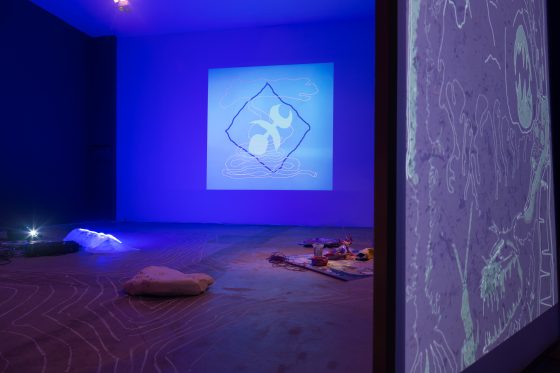
Uma Breakdown, The Formless Wastes, installation view, 2017. Image courtesy of the author and artist
Where Games Workshop increasingly emphasises top-down control, Breakdown, who is in the final year of a PhD at Northumbria University, articulates a wider engagement with the collaborative world-building potential of role-playing games (RPG). “I’m not going back to the orthodox source material,” says Breakdown. “I’m more interested in things that are fan-made and loose or misremembered.” In performance-installation TFW: The Formless Wastes (2017), which takes its title from a region of space in the 40K universe, Breakdown replaced the tradition RPG dice with a specially made tarot deck in order to create a participatory event that fell somewhere between playing a game and telling a story. “I enjoy games not when you simply follow a set of rules that someone else has decided,” says Breakdown, “but when it is more like a collaboration—when we as participants work together to create a new situation that doesn’t belong to any of us in isolation but could not exist without us all.”
Breakdown’s collaborative performance, like other contemporary artists engaging with video games and live action role-play (LARP), echoes the present tense of sci-fi, as seen in the 40K tagline: it professes to speak of a future, but its creation already begins to make that future in the present. In creating their own speculative worlds, both sci-fi and art can elide the differences between present and future, fact and fiction. In the language of speech act theory, such work is not simply descriptive but performative: through its very existence, it is already making real the speculative future that it posits. Such works ought therefore to be very careful about the dreams they begin to reify. Breakdown recognises that the politics of these performances is “utopian in a way” because they “leave the police outside”; but Capps’ work seems to be embracing the post-cyborg, biotech future that it envisages without providing sufficient challenge to who is wielding the power and making the decisions. If only accelerationists read some Mary Midgley.
Warhammer also occurs in Breakdown’s TFW: The Formless Wastes through the iconography of Slaanesh, the Chaos god of pleasure and excess. In the lore of 40K, Slaanesh is of ambiguous gender. The god’s symbol, not dissimilar to Prince’s love symbol, is often read as an androgynous combination of the icons for male and female. But it also bears a resemblance to alchemical symbols such as John Dee’s Monas Hieroglyphica. For Breakdown, the symbol and the lore that it references create possibilities for queer becomings.
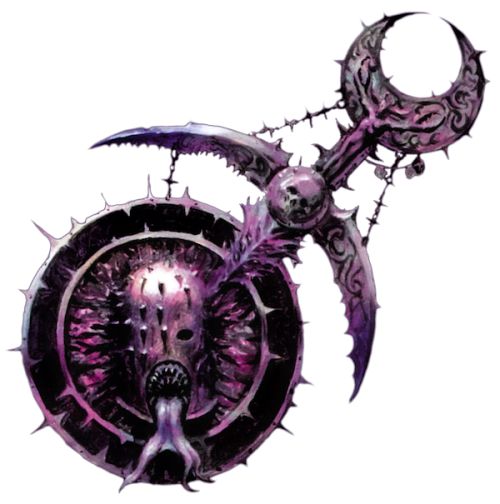
Slaanesh’s symbol
“Slaanesh is so easily understood as queer,” says Breakdown, “or as a homophobic or transphobic slur. A lot of the Slaanesh figures present characters that, although monstrous, are coded as gender-nonconforming, intersex or trans.” Breakdown draws parallels between Slaanesh and other sci-fi characters such as Elric of Melniboné in Moorcock’s writings and Nemesis the Warlock, created by writer Pat Mills and artist Kevin O’Neill for 2000 AD, as “both are on the side of radical difference, in opposition to a hyper-macho authoritative cleanliness.” Breakdown also sees an analogy between Slaanesh and writers like Hélène Cixous, Luce Irigaray and Julia Kristeva: “Slaanesh was intended as something that would gross out fifteen-year-old boys, but it can grow and be used for something else. Slaanesh has no business being aligned with 1970s feminism or post-structuralist philosophy, but it can do that.”
Breakdown’s strategy of re-appropriation is comparable to that of artist Joseph Buckley, whose work also borrows from the iconography of Games Workshop among a plethora of other references. Like Capps and Breakdown, as a child, Buckley was also fascinated by the future-oriented universe of Warhammer 40K. “The lore blew my socks off,” he says. “The idea of a deep, deep future—that was like electricity.” But thinking about both the company and its fictional universes through the critical lens of a professional artist has necessitated a process of reinterpretation.
Buckley’s interest in 40K emerges in works such as Memories of Isstvan (2015), a drawing routed into a wall at Yale School of Art, where Buckley completed his MFA in sculpture in 2015. The drawing depicts two Space Marines stabbing each other in the chest with chainswords (a weapon of choice in 40K). The title is a reference to one of the early battles in the Horus Heresy. “I was thinking about betrayal,” says Buckley.
More recently, Buckley produced The Tsar says, one hundred years ago today, “1917 must surely be better” (2017), a lightbox with ‘2016’ written in a font extrapolated from Games Workshop’s corporate logo. This work was also shown at Glasgow International in 2018. “The last few years feel like a moment when the order that we’ve inherited could break,” says Buckley, for whom the work is a reference to the arrogance of ruling classes who have, he says, “no real incentive to change the world”.
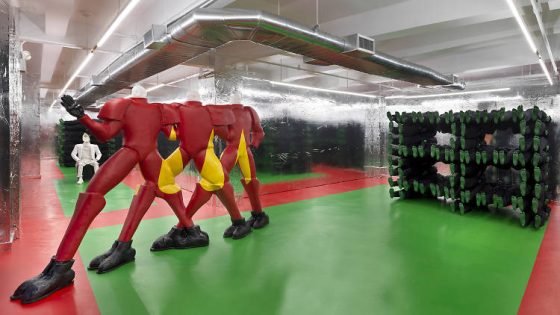
Joseph Buckley, installation view of Traitor Muscle, Art in General, 2018. Photo by Dario Lasagni. Image courtesy of author and artist
Buckley’ is especially interested in the figure of the orc. This came through clearly in a large-scale sculpture that the artist produced for his 2018 solo show, Traitor Muscle, at Art in General in New York. Entitled Orcish Shelving System (2018), the work consists of 42 humanoid figures, dressed in black with green heads, hands and feet. Made from hand-cast then spray-painted plastic, the figures are laid horizontally on top of each other to form, as the title suggests, a kind of shelving system. It looks like the type one might see in a morgue: a structure made of bodies, in which to house bodies.
Buckley’s orc is drawn from Tolkein more than from Warhammer (hence the spelling—in 40K they are orks). In line with a number of literary theorists, Buckley traces a connection between Tolkein’s conception of the orcs and the racially stratified society in which he lived. “Lord of the Rings takes the fantasy of race as a given,” says Buckley, “and that has subsequently bled into the racial dynamics of, for example, Dungeons and Dragons and Warhammer 40K.”
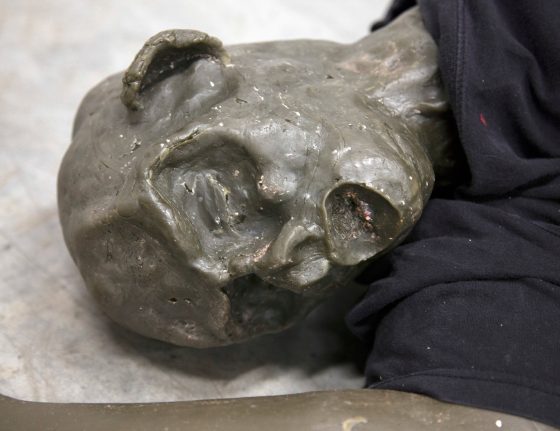
Joseph Buckley, Orcish Forms, detail, 2014. Image courtesy of the author and artist
Traitor Muscle was not the first time that Buckley used the figure of the orc within his work. In 2014, he produced Orcish Forms, another series of green-skinned figures dressed in black, this time made from used foundry wax and lying, like corpses, within a grid on the gallery floor. Buckley, who lives in New York, made these figures as a direct response to the police shootings taking place across America, and in particular the killing of Michael Brown in Ferguson on 9 August, 2014. “I use the orc as a way to think about the mechanics of dehumanisation,” says Buckley, “to think about who gets to be human and who doesn’t.”
Where the work of Capps and Breakdown imagines possible futures, Buckley’s is more rooted in a pointed critique of contemporary racial politics. He is sensitively attuned to the wielding of power. Buckley traces the long history of structural racism in which whiteness asserts its supremacy over and over again in different ways in different contexts. The figure of the orc is just one way in which he does so: “Warhammer has become a touchstone for fascism at around the same time as England has passed a moral event horizon,” he says. “There are more people who are more racist than you think.”
What the works of all of these artists show is not only the power and reach of the iconography of Warhammer 40K, but also the richness of the original source material that enables (unwittingly perhaps) such an array of re-readings. Each of these artists—Breakdown, Buckley and Capps—is using the signs and symbols of Warhammer as one tool among others in much wider artistic practices. Interestingly, at precisely the same time that one aspect of the 40K universe has become aligned with the alt-right, those working in the field of fine art are appropriating other aspects in the service of, for the most part, radically different political agendas. While Capps’s work thinks humanity in general terms (in part, a problematic result of Anthropocene thinking), both Buckley and Breakdown are engaged in the task of thinking socio-political relationships between humans within the specific context of environmental crisis. Their work therefore provides much-needed opposition to the politics of fascism and the alt-right.
“I might not be able to make work in ten years time,” says Buckley. “There might not be enough spare resources on the planet for any sculptural practices to exist. Or I, and my family and the community I am from, might be lying dead at the bottom of a mass grave. So in a way, I’m producing works for the archaeological record, as a testament to the insanity of the age that we live in.”
In 2017, following the death of cultural theorist Mark Fisher, Josephine Armistead posted a follow-up to The Silicon Ideology. Its conclusion might seem to speak directly to those contemporary artists engaging with Warhammer 40K and other related sci-fi universes. It asks questions that we all must try to answer for ourselves:
We cannot afford two more decades in the wilderness. “Socialism or barbarism” may once have been a slogan; it is now the human condition. The time has come for “Leftists” (and especially their most parasitic sub-groups—post-leftists, cultural studies liberals, and LARPers in roughly that order–for whom politics is already merely aesthetic) to answer the following questions: whose side are you on? and are you revolutionaries or lifestylists? You must decide–will you agitate among the masses, or will you write bad poetry? Will you organize to feed the people and meet their needs, or will you pray before an idol, ritualistically role-playing revolutionaries of the past?
Further Reading:
M. Ambedkar, ‘The Aesthetics of the Alt-Right’, Title (2017)
Josephine Armistead, The Silicon Ideology (2016) and The Silicon Ideology Revisited (2017)
Megan Condis, ‘From Fortnite to Alt-Right’, New York Times (2019)
Hipsterhammer, ‘On Slaanesh’ (2017)
Mary Midgley, Science as Salvation (1992)
‘Tankpot’ Zoë, ‘Slaanesh is a problem’ (2017)
Kathryn Yusoff and Mary Thomas, ‘The Anthropocene’, Edinburgh Companion to Animal Studies (2018)
—
Tom Jeffreys is a writer based in Edinburgh. He is the author of Signal Failure: London to Birmingham, HS2 on Foot (Influx Press, 2017) and is working on a new book about birch trees in Russian art, landscape and identity.